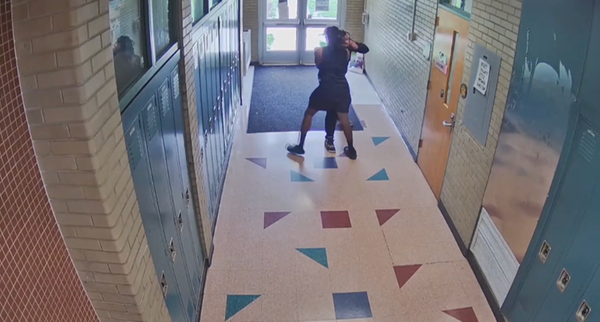
Jurassic Park was released 30 years ago, but in those three decades our perception of dinosaurs has largely remained static. In the public consciousness, they were giant, scaly beasts with huge claws and teeth who spent their days chasing down victims and ripping them apart in brutal fashion. Think dinosaur and you will probably picture a primal, primitive force of unbelievable fury.
And then along comes the new series of Prehistoric Planet (Apple TV+), which, in a single instant, undoes almost everything we thought we knew. The instant in question concerns the Hatzegopteryx: a vast, vicious-looking, giraffe-sized pterosaur. Had the Hatzegopteryx been depicted on screen at any point until now, it would undoubtedly have been to swoop down like a monster and gobble up its prey.
But Prehistoric Planet shows us something different. It shows us Hatzegopteryx’s mating ritual, which may qualify as one of the most beautiful things you will ever see. A male carefully arranges various naturally occurring trinkets around himself on the spit of an island and gently starts dancing, eyes never leaving the sky, in the vain hope that a female might pass overhead and take interest. It’s heartbreaking, lovelorn and gorgeous to watch. Hatzegopteryx – who knew?

“Nothing is primitive about dinosaurs,” says Tim Walker, Prehistoric Planet’s series producer, over a video call. “They weren’t lone hunters or killers. They were really social and they would have been really flamboyant because of the social mindset. Our mission, if you like, was to show the audience that these are not mindless monsters.”
The second series marries two irresistibly compelling forces: MPC, the visual effects house that helped Jon Favreau create his photorealistic remakes of The Lion King and The Jungle Book; and BBC Studios Natural History Unit. The results of this union are astonishing. You have all the respect and scientific rigour that you would find in a traditionally shot documentary such as Planet Earth presented with thoroughly convincing CGI. After a while, you stop noticing that it’s not real-life footage.
Part of this is down to the producers’ approach to what they depict. Mike Gunton, a Natural History Unit mainstay and the show’s executive producer, says their approach stems from the horrifying sequence in Planet Earth II where an iguana hatchling runs for its life from dozens of speeding snakes. “The reason that sequence felt so powerful was because it felt uncontrived,” says Gunton. “It was very much: ‘Oh my God, we didn’t know that was going to happen!’ We’re definitely copying that feeling here. The CGI can do anything, but we’ve tried to make it feel as if we turned up to shoot one thing, but then: ‘Oh my God! Look at this!’ We’ve tried to shoot and edit as if it were found footage.”
This approach – treat the camera as if it had been placed by a flesh-and-blood documentarian – plays out through the series. There are T rex sequences, but don’t expect any extreme closeups. When we see a T rex, Gunton explains, it’s depicted as being “pretty much shot on the longest telephoto lens in our armoury”, to stop the camera operator from being eaten. “It’s a subtle difference, but I think it’s a critical one in terms of authenticity,” he says.

Speaking of authenticity, Prehistoric Planet presents itself with the swaggering confidence of any Natural History Unit project. What we see, we are told, is how it is. That seems like a tall order, especially when making a show set millions of years ago based on data that is constantly developing. I ask Walker how the team managed to land on what to create for the series.
“Everything starts with the fossil record,” he says. “That’s our baseline. The show is set 66m years ago. So, if you look at the fossil record, what was around? Not just the big dinosaurs, but everything else that lived alongside. All animals have got to perform a suite of behaviours. They’ve all got to mate, they’ve all got to eat. All this will be dictated partly by what type of animal they are and what their environments are like. It’s a combination of the fossil record, then the experience of wildlife film-makers who have observed animals in the field. And so you can start to bring all these different disciplines together, marry them with the CGI, and you build the plan.”
This new view of dinosaurs takes some getting used to. When I first heard of Prehistoric Planet, my reaction was to write it off as a slightly jazzier version of Walking With Dinosaurs. After all, these animals are many millions of years old. What more could we have learned in the space of a couple of decades?
Quite a lot, it turns out. “We have a weekly scene meeting with our production team,” says Walker. “Our lead scientific consultant, Darren Naish, is part of that team. Each week, we have Dr Darren’s Dino Download, in which he gives us the latest news from palaeontology world, and we have to guess how many new dinosaurs have been described. On average, each year, over the last couple of years, a new dinosaur has been described every week.”
That is a lot of new dinosaurs, I say. “Who knew that palaeontology was such a fast moving science?” Walker replies, with a grin.
In fact, Prehistoric Planet has even helped to nudge our understanding of dinosaurs forwards a little further. “There’s a mosasaur sequence, where we show it jumping out of the water,” says Walker. “The team that we were working with didn’t fully know how the mosasaur could propel itself as fast as we show it. And so they set about doing a bit of academic work to find out the velocity that this particular type of animal could achieve.”

Gunton adds: “They knew the mosasaur was an ambush predator. But they weren’t sure how it could generate the thrust to accelerate at such speed. They had some suspicions, so they formulated a calculation.”
“Look, here it is,” says Walker, palpably giddy as he holds up his phone and shows me a mathematical formula that takes up his entire screen. “There is extraordinary scholarship here,” says Gunton. “Every single minute, every single second, is underpinned by serious and deep scientific interpretation. That’s one of the things that we’re super-proud of. The science and the reality of how you shoot this forces you into a position where it feels true. And we know from watching documentary, the truth of the world is always more engaging than something that we make up.”
Realism was less important in terms of the CGI, however. The series may be consistently breathtaking, but, to sell it to viewers, Gunton and Walker found themselves having to pare it back. “Some of the photography that we can now do in the real world, and that we’re currently doing with Planet Earth III, is insane,” says Gunton. “But if we did that in Prehistoric Planet it would look wrong.
“This is a conversation we’ve had with Jon Favreau. We’ve dialled down the photography, because otherwise it would have looked like a VFX show. The footage here feels more akin to what we were filming maybe eight years ago. It’s a really weird mind game to play.”
Another thing that helps to sell the show, of course, is the participation of Sir David Attenborough, who not only narrates but also presents several sequences to camera. He is such a warm and reassuringly authoritative presence that you sense the producers could have staged a CGI dinosaur dance sequence and Attenborough would be able to convince you that it was scientifically accurate. “Not bad for 96,” says Gunton of his longtime collaborator.

Attenborough’s participation was not a done deal, however. “He was very assiduous,” says Gunton. “If he was going to do this, then it had to be the last word on the matter. And it had to be all about authenticity. No fantasy. I remember the day we first showed him footage; he sat there watching on the computer, tapping his fingers. When it finished he turned to me – he’s so theatrical – and he paused. Eventually, he said: ‘I don’t know how you could have done it any better.’ He works on the scripts. He’s been a fantastic asset, of course, a fantastic supporter. But also you still get notes. He’s 96 and he still gives notes.”
Earlier this year, there were reports that the BBC series Wild Isles would be Attenborough’s last appearance filming on location. Gunton is one of his closest professional collaborators – and perhaps his most qualified successor – so, as we wrap up, I ask if the rumours hold any truth.
“I’ve been working with him for 35 years,” Gunton says. “The first show I worked on with him was The Trials of Life, and the news then was that this would be David Attenborough’s final series.”
So that’s a no? “The only person who knows when it’s David’s last year is David. He’s in this project, and I’m working with him on at least two other projects in which he is a significant contributor.” Could one of them be Planet Earth III? “Could be,” says Gunton, grinning. “He’s still working and he’s still amazing.”
Prehistoric Planet Season 2 is on Apple TV+ from 22 May.







